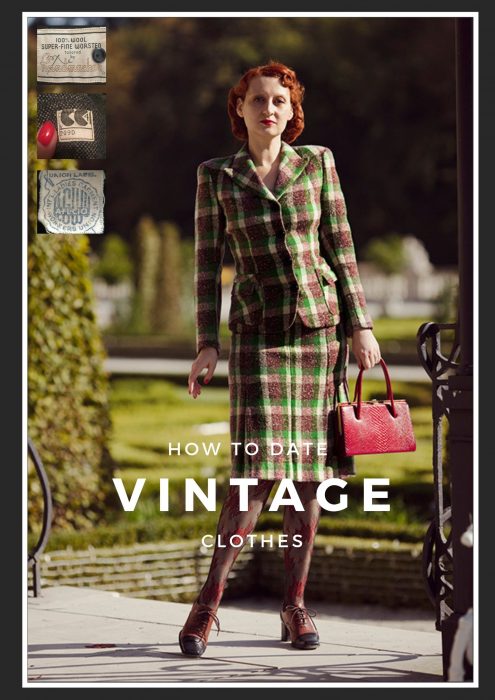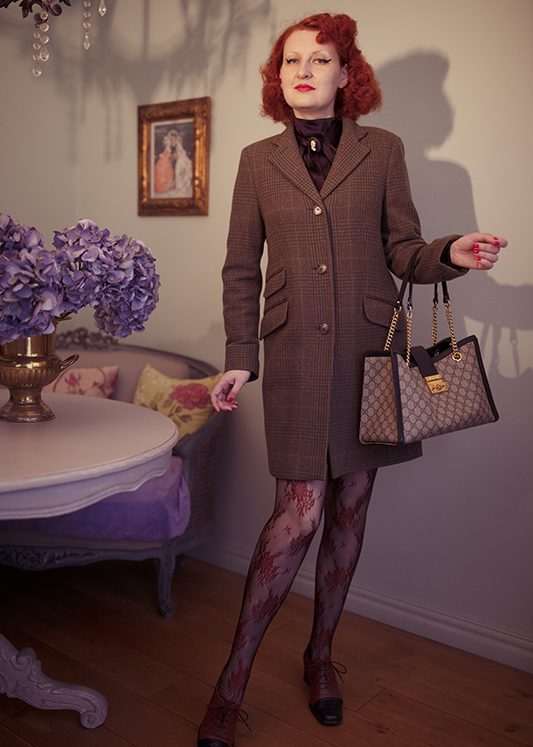How To Date Vintage Clothing
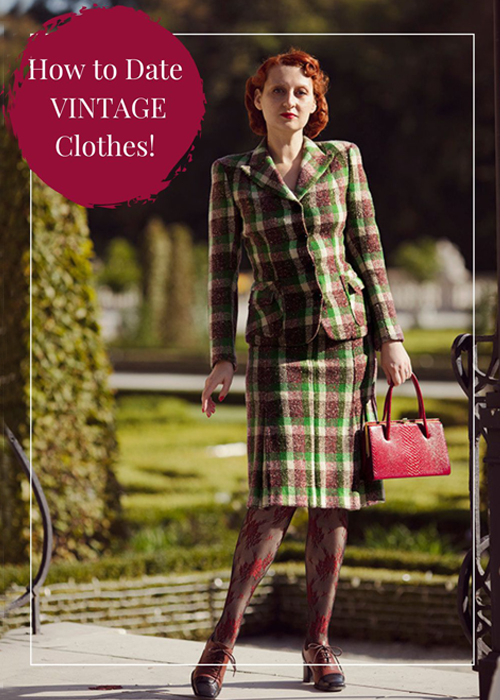
Last updated on June 18th, 2024 at 11:43 am
- What is Considered Vintage?
- The Art of Identifying Vintage Clothes-Pro Tip
- Dating Vintage Clothes by Zippers
- Establishing the Age of Vintage Clothes by Lining
- IDENTIFYING VINTAGE CLOTHES BY SEAMS
- How To Fix a Hole in Vintage Clothes Without Sewing
- Care Tag on Vintage Clothing
- Pro Tip for Dating Vintage-Care Tag
- Care Symbols on Vintage
- Textile Fibre Products Identification Act
- Care & Fibre Content Labelling in the UK
- You might be interested in my article on how to clean vintage clothes headache-free!
- How To Get Rid Of Yellow Stains from Vintage Clothes & Linens!
- Trademark Electronic Search System (TESS)
- CC41-The Utility Clothing Scheme
- How to Date Vintage by RN
- LOT Number on American Garments
- ILGWU Union Tags (International Ladies’ Garment Workers’ Union)
- Woolmark Logo-A Great Clue for Dating Vintage
- The Strange Size Can Tell You How Old is Your Vintage
- British Dress Sizes During WWII
- Vintage Lingerie Sizes
- Tips on Dating Vintage Clothes by Fabric
- Vintage Ads are a Great Way to Finding Out How Old is Your Vintage
In this article, you will discover the art of dating vintage clothing with expert tips and tricks, unveil the hidden clues and learn how to identify the era in which a vintage garment was made. From examining the lining to checking the RN number, this guide will equip you with all the essential knowledge to help you date vintage clothes like a pro.
Time needed: 10 minutes
How old is my vintage garment?
- Firstly, certain clues will help you establish the era when your vintage garment was made. Dating vintage clothes is both an art and a science and it can take years of experience to master the skill, but I want to focus on the main signs that will get you started.
We will look at:
☞ ZIPPERS
☞ LINING
☞ SEAMS
☞ CARE TAG
☞ WHAT’S ON THE LABEL (TESS)
☞ RN
☞ ILGWU UNION TAGS-for American garments
☞ WOOLMARK LOGO
☞ FABRICS
☞ VINTAGE ADS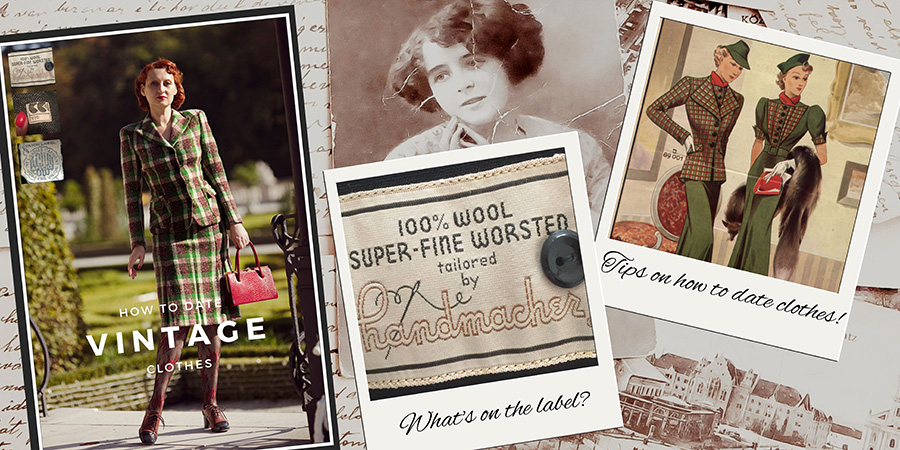
- Secondly, search through fashion archives and you might find an ad or editorial that features garments identical to or at least similar to the one you are researching.
You should check archives of Vogue, Harper’s Bazaar, Women’s Wear Daily, Sears Catalogs, NYPL Digital collections, and Newspaper Archive. I found my Handmacher suit in an ad in Harper’s Bazaar from 1952!
What is Considered Vintage?
The word ‘vintage’ refers to the year in which wine was produced.
Etymology in a nutshell: From Old French vendange (wine harvest), from Latin vindemia-grape gathering (from ‘vinum’ wine).
☞Ah, yes! It gets much more complicated when it comes to fashion and you will get a different answer depending on whom you ask.
☞ For many, the garment has to be at least 40 years old to qualify as vintage.
☞ In recent years, the word vintage replaced the term ‘second-hand’ to make it more appealing to the buyer. You will often see in editorials the word ‘vintage’ used to describe a designer piece from a few seasons ago.
☞ The reason why a lot of us in the vintage community started using the term ‘true vintage’ is to separate us, the wearers of 1930s-1950s garments from those who refer to clothes from the 90s and 00s as vintage.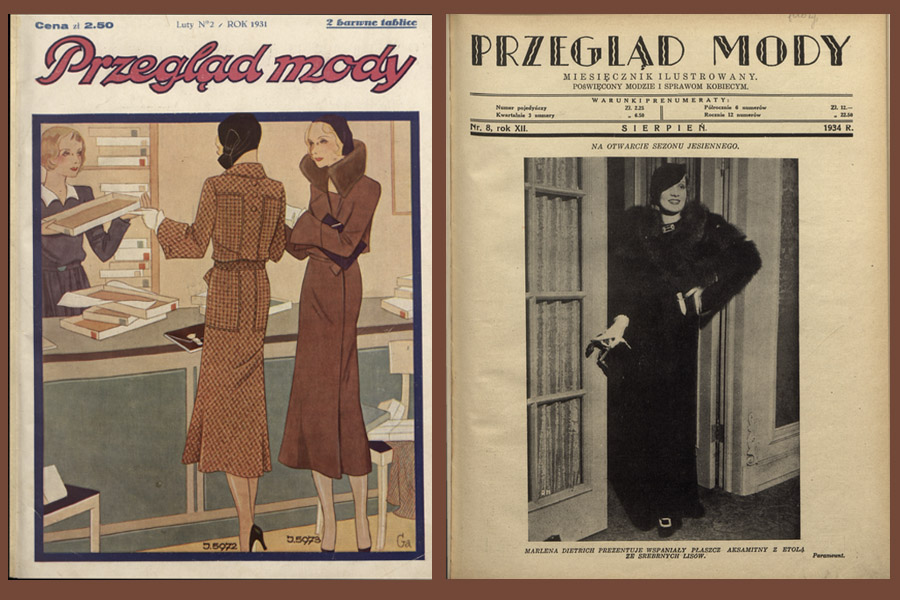
☞ Generally speaking, a piece of furniture or a garment has to be at least 100 years old to be an antique.
☞ True vintage (the 1930s-1950s), vintage (1960s-1980s), retro (imitation of a style from the past).
☞ To describe the years 2000-2020 in fashion, I will quote a character from The Devil Wears Prada.
‘If she deosn’t like it she shakes her head. Then, of course, there is the pursing of the lips.’ And that means. ‘Catasrphe.’
Needless to say, I’ve been pursing my lips since the late 90s.
The Art of Identifying Vintage Clothes-Pro Tip
It’s not always easy to identify the era in which a vintage garment was made. It’s a very tricky and daunting task indeed, especially when there are no tags attached. And that’s the case with a lot of garments from the 1930s-1950s. Clothes were often handmade, or perhaps the tags simply did not survive the wear and tear of time.
Some of my most valuable 1940s skirt suits were bespoke and undoubtedly made for well-to-do clients.
PRO TIP: Familiarize yourself with various styles and trends popular in the fashion era of your interest. Look for vintage magazines and ads. You should also know how to identify the different fabrics that were used in different eras.
As much as the topic of the history of vintage clothes is a never-ending learning curve for me, there are certain ways by which I’m able to date most but not all of my collected pieces.
Readers have asked me many times to write a post about that very topic and I hope my tips will be useful!
The older I get, the more vintage I buy and the deeper I fall into the rabbit hole of research, the more I realize that there is still so much to learn.
Before you continue reading my post, please, do understand that when dating vintage garments, you should look at many different clues. Don’t obsess over just one. Also, I regularly update this article so do subscribe to the post notification.
Dominique de Merteuil
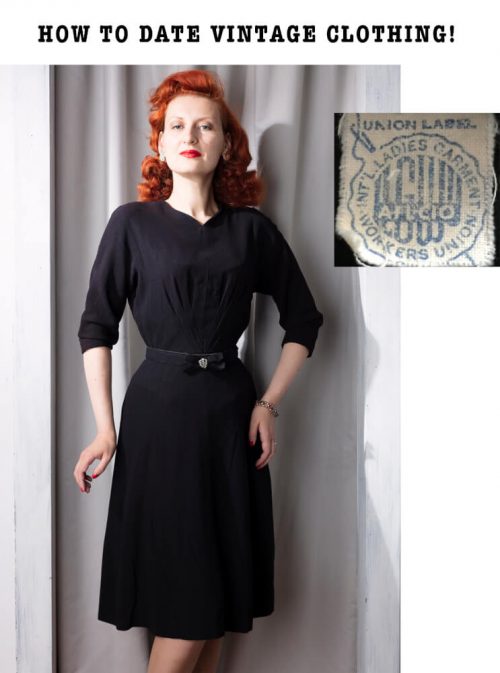
RELATED
If you love vintage fashion as much as I do, you might also find this article interesting! HOW TO TAKE CARE OF VINTAGE CLOTHES!
How to date vintage clothing! In the pictures, I’m wearing a dress from circa 1955.
Dating Vintage Clothes by Zippers
Learn How to Date Vintage Clothing with the Help of Zippers, Lining and Care Tag
I find zippers fascinating and they certainly deserve a separate chapter or even a post. For the time being, you have to forgive me for giving you just a couple of simple clues on how to date a vintage garment thanks to zippers.
BRIEF HISTORY OF THE ZIPPER
- Elias Howe, a brilliant American inventor who in 1846 received a patent for the sewing machine using lockstitch, was also the first one to patent an “Automatic, Continuous Clothing Closure”, a 1951 predecessor to what we know as the zipper.
- In 1893, Whitcomb Judson took Howe’s idea further by developing a hook-and-loop fastener for shoes. Around 1917, Gedeon Sundback, a Swedish-American Engineer, added the number of teeth to the zipper making it more secure.
- It wasn’t until 1923 when Sundback sold his invention to the Swiss industrialist Martin Othmar Winterhalter that the original fastener was improved by replacing the balls and clamping jaws with ribs and grooves. The new and improved fastener was known as Riri and was first manufactured in Wuppertal.
- As far as the term ‘zipper’ goes, it was first used by the American company called B.F. Goodrich used Sundback’s design on boots and named the fastener after the sound it made when used.
Zipper was Goodrich’s trademark for boots and overshoes made of rubber and fabric.
United States Court of Customs and Patent Appeals, March 1, 1937
- Though the metal zipper was invented in the 1800s it was only first used in women’s clothes in the 1930s and placed either in the side seam or centre back of the dress, usually very short in length, concealed with a flap of fabric, as it was considered vulgar. You see, zippers made it too easy to take one’s garment off and a real lady wouldn’t be in a hurry to undress. Or would she? 🙂
- I really struggle to find 1930s evening gowns that would be the right size and have a zipper, without which putting on a velvet or liquid satin gown is almost impossible, at least for me.
And that brings me to the topic of alterations. I would like to remind you of what I said earlier about looking at more than one clue when dating vintage clothes. You might find an original 1930s dress or a 1940s skirt with a modern zipper.
- Contrary to the popular belief of many people on the internet that 1930s clothes did not have a front zipper, there are MANY examples of 1930s dresses, blouses and patterns with a zipper placed in front.
TIP * Vintage patterns that can be found on Etsy and eBay are a great resource for learning about the different styles popular from the 1930s to the 1950s.

Elsa Schiaparelli used colourful plastic ‘Lightning’ zippers in her 1935 collection and shocked everyone by placing them in very visible parts of her clothes.
She wasn’t the first designer to use a fastener in a woman’s garment though. In 1933 the American couturier, Charles James incorporated a long zipper in his spiral wrap-over dress which he named the ‘Taxi’.
- You will often find a metal zipper in women’s clothes from the 1940s in the side seam, sleeves as well as on the back. All of my 1940s dresses have either a zipper or buttons placed in the side seam.
- In the 1950s it was popular to place a long zipper at the centre back of the dress but always concealed. Don’t be surprised to see a 1940s gown with a long zipper that runs down the back.
Stills from “Blithe Spirit” (1945) depict not one but two dresses with a very long zipper on the back.


- Plastic zippers replaced metal ones after 1963
NOTE that some zippers might have been replaced at a later stage! I’ve seen many 1940s dresses with a contemporary zipper.
Lining
Establishing the Age of Vintage Clothes by Lining
In the 1930s, 1940s and 1950s, women always wore slips and half slips with skirts and dresses. Of course, slips were still popular in the 1960s and 1970s but most skirts came with a lining.
Tip* If you find a skirt suit that looks like a great example of one from the 1940s but the skirt is fully lined, then you can be sure that it’s from the 1970s or later.
I have several skirts and one dress from the late 1950s with a half-lining, like the one in the picture below.

How to date vintage clothing!
The 1950s Copeland Skirts of California with a lining at the back of the skirt.
IDENTIFYING VINTAGE CLOTHES BY SEAMS
This, for me, is the most difficult way to identify a vintage garment, as I don’t know how to hand-sew, I’ve never used a sewing machine, and even attaching a simple button is like a mission impossible.
So… For me looking at different types of seams is like trying to read hieroglyphs. The one thing I’ve learned really fast though is that if a garment has unfinished seams it‘s most likely from earlier than the 1950s.
The three seams you should familiarise yourself with are French, pinked and Serged seams.
- In a French seam, which I call the invisible seam, the raw edges of the fabric are completely enclosed and this type of seam was used from the 1900s through to the 1940s.
- You will find pinked seams on a lot of 1950s garments that were cut with pinking shears and the easiest way to identify them is by the zigzag teeth cut of these shears.
- Serged seams, which are overlock stitches, replaced the pinked seams in the 1960s when the Serger sewing machine became widely available and affordable.
TIP *Please note that the overlock/serger machine was developed in the 19th Century by Merrow Machine Company and a line of “A Class” machines was produced in 1932. Don’t be surprised if you find an overlock stitch in garments pre-dating the 1960s. I’ve seen it on breeches and a skirt from the 1930s.
How To Fix a Hole in Vintage Clothes Without Sewing
If you are as hopeless when it comes to stitching, sewing and mending, as I am, you will LOVE the Bo-Nash Fuse It Powder!

Care Tag on Vintage Clothing
- In 1971 the Federal Trade Commission issued the Care Labeling Rule. The rule states that manufacturers have to tag their apparel with at least one cleaning method such as “dry clean only” or “machine wash cold”.
The Care Labeling Rule has been in effect since 1971 and requires manufacturers and importers to attach labels with care instructions for garments and certain piece goods, providing instructions for dry cleaning or washing, bleaching, drying and ironing clothing.
FTC
- There are a lot of 1970s dresses inspired by the 1940s but if you see a tag bearing the words “dry clean only”, and the dress happens to have a lining, and it’s made of polyester, you can be sure that it’s NOT from the 1940s!
- The lining would be your second clue that the dress is not from the 1940s.
- The polyester fabric would be the third clue.

Pro Tip for Dating Vintage-Care Tag
* Care instructions on clothing from the 1950s and 1940s were not that uncommon but the wording on the tag will be most likely ” DRY CLEANING RECOMMENDED” rather than “DRY CLEAN ONLY”. I once bought a deadstock 1950s dress with a removable care tag attached to the dress and kept the tag. I will post a picture of it as soon as I find it!
If you happen to have a vintage garment predating the 1950s with ‘dry cleaning’ as a recommended method of cleaning on a tag, please let me know! I would love to post more examples on my website.
A couple of days ago, one of my favourite vintage shops in the UK, Gingermegs Vintage, listed this beautiful 1940s dress by Dorothy Hubbs. As you can see, the tag on this 1940s dress reads Dry Clean Only. So there you have it, there are always exceptions to every rule.

The Dorothy Hubbs Brand & Lucille Ball
On a side note, all the dresses that Lucille Ball wore on the TV show ‘ I Love Lucy’ were by Dorothy Hubbs.
We read in the book “The Real Story of Lucille Ball’ that
“On television, Lucy also wears the “I Love Lucy” dresses made not by her dressmaker but by Dorothy Hubbs Inc. and sold in three thousand stores around America.”
Care Symbols on Vintage
According to GINETEX ( the International Association for Textile Care Labelling), the care symbols were introduced in 1963.
The wash code symbols on garment labelling changed in 1976, 1980, 1982 and again in 1994. I will add pictures depicting care symbols in the 1960s, 1970s and 1980s in due course.

Textile Fibre Products Identification Act
The Textile Fibre Products Identification Act was introduced on September 2, 1958. You will see a content disclosure in the labelling of American garments from the 1960s and onwards.
Public Law 85-897
AN ACT
To protect the producers and consumers against misbranding and false advertising of the fiber content of textile products, and for other purposes.
Public Law 85-897 – SEPT. 2, 1958
Care & Fibre Content Labelling in the UK
According to the information I found on GOV.UK, the label must show fibre content, including fur.
I found on the website of Bolton Consultancy Ltd which specialises in care labelling that,
During the 1960s the UK adopted the national care labelling scheme and the Gyntex symbols but in the UK the textile care instructions are not mandatory.
You might be interested in my article on how to clean vintage clothes headache-free!
DISCLOSURE; As of October 2021 (three years after I published this article), I’m part of the Shop Style Collective affiliate program and I get a commission for purchases made through some of the links in this post. When you purchase a product via the link in my post you are helping to keep my website alive for which I’m very grateful!
I handwash all my vintage lingerie in Eucalan Wrapture which I wholeheartedly recommend to all of you!

How To Get Rid Of Yellow Stains from Vintage Clothes & Linens!
Retro Clean is my secret weapon in removing yellow stains on vintage and antique washable linens and clothes!

My little miracle worker made all the stains disappear.

Trademark Electronic Search System (TESS)
- If you see a brand’s name on the label, I strongly recommend that you check if it’s listed on the Vintage Fashion Guild’s website, as it’s a good source of information and they have pictures of vintage tags so you can compare it with the one sewn in your garment.
- TRADEMARK ELECTRONIC SEARCH SYSTEM (TESS)
- ‘It’s all in the name.’ If you are lucky enough to have a manufacturer’s or designer’s name attached to your garment, check TESS to see when it was registered. It won’t help with establishing the exact date of when your vintage piece was made, but you will at least find out when the brand was registered. This is a database for American companies.
- Example of a St Michael Label courtesy of Emma from NYLON NOSTALGIA. You can read an in-depth article about how to date St Michael labels on her website!

CC41-The Utility Clothing Scheme
CC41 (Civilian Clothing, Orders 1941) – the utility logo (Rationing of clothing started in 1941 and lasted until 1949). The utility clothing scheme started in 1942 and lasted till 1952. Garments with the CC41 logo on them were synonymous with good quality for a low price.
CC41 logo on one of my 1940s skirts.

How to Date Vintage by RN
Registered Identification Number
- Very helpful in determining the age of your vintage garment are RN numbers (issued by the Federal Trade Commission to businesses in the U.S. that manufacture, import or sell; textile, wool or fur products).
- RN numbers issued from 1952 through 1959 starting at 00101 continued to 04086.
- If the RN number is 13670 then your garment is younger than 1959!
- Please remember that the RN number does NOT show the number of when a garment was made, but the date of when the RN number was issued!
Tip* I use RN database to find more information.
LOT Number on American Garments
I had to mention the LOT numbers because the LOT tag appears on some of the vintage clothes and a lot of people ask about them, but I would ignore them as a clue for dating vintage.
- The lot numbers were a way for manufacturers to keep track of their garments. I’m still gathering information on when they were first used and if they really ceased to exist post-1979.
- Mary, in the comment section, pointed out that LOT numbers didn’t cease to exist after 1979 and are still in use. I have never seen a tag with a LOT number on contemporary American clothes so this topic needs further investigation.
ILGWU Union Tags (International Ladies’ Garment Workers’ Union)
Union tags are a great clue to help with establishing when a vintage garment was made.
- 1900 – 1936 ILGWU AFL (The International Ladies’ Garment Workers’ Union was formed in 1900)
- 1933-1935 NRA (National Recovery Act) with Blue Eagle
- 1936 – 1940 ILGWU CIO
- 1940 – 1955 ILGWU AFL
- 1941 – New York Dress Institute Label created
- 1955 – 1995 ILGWU AFL-CIO (In the picture below!)

How to date vintage clothing! ILGWU AFL-CIO label was found on one of my dresses.
The union tag is not older than 1955 and not younger than 1963 as there is no R symbol or “Union Made” inside the circle.
You will see the words “UNION LABEL” right above the scalloped crest, a needle with thread and no R symbol, which appeared on this label in 1964.
- 1963 -1973 ILGWU AFL-CIO (The R symbol appeared and the word UNION MADE is now inside the circle)
- May 1960 – Coat & Suit Industry Recovery Board Label and the ILGWU label were merged.
- 1974-1992 ILGWU AFL-CIO (Red colour is added)

Union label picture © Cornell University ILR School.
- 1995 – 2004 UNITE!
- 2004 – UNITE HERE
“R” TRADEMARK
The Trademark Act of 1946 introduced the trademark symbol.
Woolmark Logo-A Great Clue for Dating Vintage
The Woolmark logo first appeared on tags of garments made of wool in 1964. Also, garments with a 100% Woolmark logo will be not older than 1964. The Woolmark blend logo was introduced in 1971.
Through the years the logo has changed but you can see and compare the different tags on the Vintage Fashion Guild’s website.

This particular tag is from my 1952 Handmacher suit. As you see, it says “100% WOOL SUPER-FINE WORSTED.”

The Strange Size Can Tell You How Old is Your Vintage
None of my dresses and skirt-suits from the 1930s and 1940s have a size tag, which shouldn’t come as a surprise as it wasn’t until 1958 that standardised sizes appeared on tags.
It doesn’t mean, of course, that size tags on clothes from pre-1958 didn’t exist. They did, but the number might make no sense to you as it won’t correspond to the sizes of contemporary clothes.
You might see letters instead of numbers. “SW” – a small woman, and “W” means average size.
A lot of garments made post-1950s will have sizes ranging from 10 to 20. Size 10 would be an XXS.
In the US, as opposed to Britain, half sizes were used on clothes. Please remember that American clothes with half sizes were also sold in Britain.
When buying vintage online pay attention to the measurements given in the description, and allow 2 inches for ease of wear.
For example, if a blazer measures 36 ” across the bust it will be suitable for someone who is 32″ or 34″. Don’t forget to ask about the shoulder-to-shoulder measurement if it’s not already in the description.
British Dress Sizes During WWII
Thank you Emma of Nylon Nostalgia for this press clipping!

Instead of garments being known as S.W., W., or W.X., ore described by bust or hip sizes, they will be called by letters of the alphabet sizes A, B, C, C &c. For each of the sizes prescribed the garment will have to conform to certain minimum measurments. Altogether, 36 sizes have been laid dow, and it is hoped that the system will provide to supply women with garments which, because of their sizing, will give good coupon value.
Vintage Lingerie Sizes
On June 29, 1944 at the instance of the Office of Price Administration, a recommended commercial standard for women’s slips (made from woven fabrics), developed and adjusted through several conferences and through consultation and correspondence with industry and the trade, was circulated to producers, distributors, and users for written acceptance.(…) The standard is effective for new production from April 20, 1945.
U.S. Department of Commerce. Henry A. Wallace, Secretary

PURPOSE
The purpose of this commercial standard is to establish standard methods of measuring and standard minimum measurments for the guidance of producers, distributors, and users of women’s slips in order to eliminate confusion resulting from a diversity of measurments, and methods to provide a uniform basis for guaranteeing full size.
SCOPE
This standard covers standard methods of measuring and standard minimum measurments for women’s built-up shoulders, and strap-type, straight and bias cut slips, made from woven fabrics, in sizes 32 to 54.
COMMERCIAL STANDARD CS121-45

Tips on Dating Vintage Clothes by Fabric
You can date vintage clothes based on the fabric they were made of which, obviously, isn’t possible when buying online, unless the information pertaining to fibre content is included on the tag.
Prior to 1958, garments did not have to have labels with fibre content. That changed when Congress passed legislation called, the Textile Fiber Products Identification ACT, which required all fabric manufacturers to include accurate fibre content on the label.



Rayon Fabric
Rayon, invented in 1846, was first manufactured in the United States in 1911. (very popular in the 1920s-1940s). Rayon, which was a cheaper alternative to silk, was called artificial silk until 1924. Other names used to describe rayon were; artificial silk, art silk, rayon silk, chemical silk, and manufactured silk.
In 1924, the National Retail Dry Goods Association appointed a committee to create a new universal name for the fibre known as “artificial silk’. Kenneth Lord of Galey and Lord, a leading fabric manufacturer, came up with the name “RAYON” which was unanimously accepted.
The First UK production of Rayon was in 19o5 Courtaulds.

THE MOST POPULAR RAYON PRODUCERS WERE;
“Viscose Co. with its President, Samuel A. Salvage who was named by a rayon trade paper as “the father of the American Rayon Industry.” Viscose was the property of the English Courtalds’ Ltd. and was the largest producer of rayon in America.
Celanese Corporation of America was third in output (35,000,000 pounds annually according to The Literary Digest from January 16, 1937), but best known to consumers because of brilliant marketing campaigns. “The company has always insisted the its Celanese is not rayon.” Celanese is the Celanese Corporation’s trade name for acetate discovered by the Dreyfus brothers, Henri and Camille.
By 1937, most rayon is still produced by the viscose processes.
The du Pont Rayon Co., which manufactures rayon by both, acetate and viscose processes, declares that rayon yarns of the acetate type are more immune to stains from perspiration, grease, ink, fruit juices; they absorb less moisture and have superior draping qualities.”
Acetate Rayon Fabric
The first UK commercial production in 1921 Dreyfus as Celanese.
The first US commercial production of Celanese was in 1924 by Celanese Corporation.
Nylon Fabric
1939 – Nylon (nylon was first commercially used in 1939 by E.I. du Pont) Qiana, a silky nylon fibre was developed in 1962 and introduced by the name of Qiana in 1968 by DuPont. That particular material was very popular in the 1970s in the production of faux-silk men’s shirts with bold patterns. A la Travolta “Saturday Night Fever” 😉
Nylon; Bri-Nylon and Perlon were first commercially manufactured in the US in 1939. DuPont.
Acrylic Fabric
1950 – Acrylic (DuPont created the first acrylic fibres in 1941 and trademarked them under the name Orlon. It was developed in the 40s, commercially manufactured in 1948, and wildly available in shops in the 1950s. The early Orlon did not hold dyes and was mainly used for curtains in a beige colour.
Regina Lee Blaszczyk wrote in her article, Styling Synthetics: DuPont’s Marketing of Fabrics and Fashions in Postwar America that, “In 1953, DuPont introduced another type of Orlon fiber, which found its way into the knitting industry. Italian knitwear had stimulated the demand for sportswear sweaters, and Orlon proved to be the ideal fiber for mass-market knitters looking to capitalize on the fad for ladies’ twin sets.”
It’s a soft and warm wool-like fabric used for example as an alternative to expensive cashmere)
1950s Haute Couture in Synthetic Fabrics by DuPont
ORLON FABRIC IN HAUTE COUTURE
Between 1952-1954 DuPont collaborated with Parisian Haute Couture designers such as Dior, Chanel and Givenchy.
Givenchy incorporated Orlon acrylic in his 1954 collection, and by doing so cemented the fabric’s position in the world of luxury wear.
“Hubert de Givenchy finds the way to keep this shirtwaist dress looking young and bouffant-he chooses Orlon acrylic fiber, here combined with silk in a douppioni surah. He says that because of Orlon, this surah can cooly glide through a day in the sun-or even careful handwashing-and still look as fresh, frosty, and shimmering as the day it was photographed in Paris.”
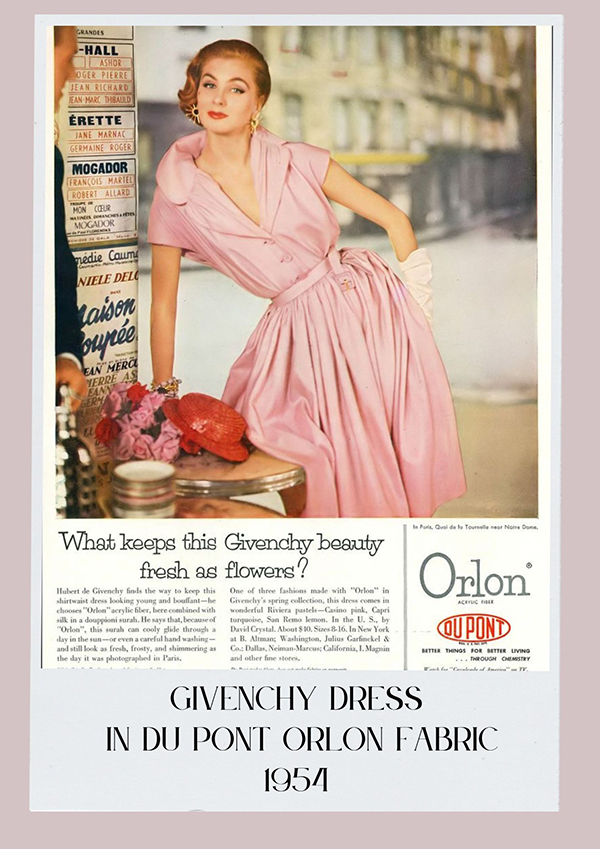

In 1955, Givenchy designed beautiful sweaters, cardigans and skirts made of Orlon for the American Talbott firm.
How to date vintage clothing guide.
Spandex
Spandex was invented by Joseph Shivers, DuPont in 1958. The fabric was first commercially used in the US in 1959 by DuPont.
Lyocell (Tencel, Ecovero)
Commercially available since 1988, Courtlands UK.
1961 – Polyolefin/polypropylene (in 1966, polyolefin was the first and only Nobel Prize-winning fibre).
If you see rather unusual names of fabrics it usually means it’s vintage. For example;
Dacron Polyester
Dacron Polyester was developed in the 1940s but first appeared in garments in 1950. The fabric started gaining in popularity when the Brooks Brothers introduced the polyester-cotton permanent press shirt.
Polyester was very popular in the 1970s but was first commercially used in 1953 and Celanese was an acetate fabric softer but stronger than satin or taffeta and most importantly much cheaper.
Vintage Ads are a Great Way to Finding Out How Old is Your Vintage
When you are lucky enough to have a tag with the brand’s name attached to the garment, look through Pinterest or Google for vintage ads with the brand in question and even if you don’t find the exact same model of a dress, suit or a coat that you have, it might help you to narrow down the date.
Being the tenacious person that I am, after two days of searching and going through countless Handmacher ads, I found a picture of my Handmacher suit in Harper’s Bazaar from 1952!

How to date vintage clothing! In the picture on the left, I’m wearing the exact same model of the Handmacher suit which I later found in Harper’s Bazaar from 1952.
The 1930s Fashion Illustrations
I published a post depicting fashion illustrations from January 1930 to September 1939. If you subscribe to my newsletter, I will send you 10 PDFs over the next 10 weeks with over 600 fashion illustrations from the 1930s.


I sincerely hope that this post was useful to you! If you enjoy my articles, please consider a donation to my book fund. Thank you!
Dominique x
